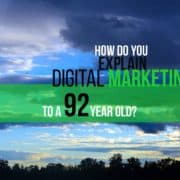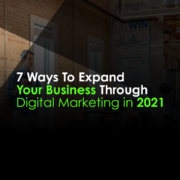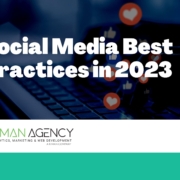How to Create a Holistic Digital Marketing Strategy for Your Business
 What is a holistic digital market strategy? How do I create a successful plan? What factors should I consider? Here is what you need to know!
What is a holistic digital market strategy? How do I create a successful plan? What factors should I consider? Here is what you need to know!
How to Create a Holistic Digital Marketing Strategy for Your Business
Digital marketing plays a critical role in connecting your company with your customers. It establishes a solid business relationship with your existing and potential customers, whether on Google through PPC or SEO, social media, or email marketing.
A holistic digital marketing strategy is an integral part of your business, allowing you to cover all aspects of marketing and promotional campaigns you run to drive traffic or customers to your website or other platforms and boost revenues. Today’s article will discuss creating a holistic digital marketing strategy. Read on!
Define Business Objectives
According to Tarek Riman, a professional digital marketer, you must understand your overall business driver, whether increasing sales, gaining market share, or expanding business. Defining business objectives is critical because they let you know the difference between micro and macro conversions.
Riman says macro conversions do not exist without micro-ones or vice versa. Therefore, what your company wants to achieve is an integral part of your business goal. It also includes focusing on your company’s mission and vision.
The purpose is to link everything together and streamline the process. You can’t set up marketing objectives efficiently and quickly and continue assuming that they will act as meaningful guides to action. Riman recommends focusing on a hierarchical goal breakdown structure to link your high-level objectives to clearer daily goals.
Business marketing objectives can tell you about the direction in which your marketing and business activities move, but this requires thorough planning, development, and implementation. Goals guide your day-to-day marketing activities and streamline the entire process. Consider the following factors when defining objectives:
- Begin with a broad design and keep all goals in the hierarchy
- Encourage your employees to understand the objectives
- Develop realistic objectives and use resources appropriately
- Analyze your company’s external opportunities, threats, and constraints
- Consider the creative conception strategies
- Consider the cost of each activity you want to carry out
- Reconsider and redefine our objectives from time to time
Perform Market Analysis
According to Tarek Riman, performing marketing analysis is integral to creating a sophisticated digital marketing strategy for your business. So, move beyond the fundamental concepts covered in SWOT or PESTEL analyses to understand your market and define your target audience.
When working on this holistic digital marketing strategy phase, you must collect valuable feedback and analyze it to generate broad insights into your target market. Make sure you focus on:
- Age range
- Likes and dislikes
- Kind of brand they like
- Types of pages they follow on social media
When you move beyond the traditional approach and develop more in-depth marketing insights, you can better select your marketing mix and use the budget appropriately. For example, you can reduce costs and spend money on relevant marketing channels.
Remember, extensive market analysis is daunting and time-consuming. However, it can help you gain an in-depth understanding and knowledge of your target audience. Riman Agency can carry out the process via thorough market analysis to help you define your target audience and its characteristics.
Create Audience Personas
An audience persona is a fictional, generalized representation of your ideal client or customer. Because personas allow businesses to view their products or services from their perspective, building a perfect customer persona can help you target your audience and improve your methods to solve their problems.
However, you can build the best customer personas on actual research, surveys, and interviews of your target audience. The problem is that following this approach takes time, resources, and money.
Sometimes, companies don’t have enough time, resources, and money to conduct surveys, research, and interviews with their target audiences. However, you can gain valuable insights from small-scale research.
For example, you can pull together a small focus group or interview a few customers. On the other hand, if you think this is impossible, you can follow a fictional approach to creating buyers’ personas.
According to Tarek Riman, author of bestselling digital marketing books, a company must focus on accuracy and precision when following a fictional approach and use information about consumers from previous research studies, web analytics, or email queries.
In addition, an audience persona allows you to act more strategically with your digital marketing methods and execution. It enables you to customize your business or marketing messages to your target audience and streamline communication strategies.
Tarek Riman recommends starting with 2-3 buyer personas. However, if you need more, feel free to create them. Some businesses create 15-20 buyer personas with different characteristics and choose the one that best fits their needs and consumers’ requirements. Consider the following:
- Who?
- Background
- Job
- Career
- Martial status
- Demographic data
- Age
- Gender
- Location
- Income
- What?
- Goals
- Primary and secondary goals
- Concerns and challenges
- Solutions to overcome challenges
- Why?
- Realistic goals
- For example, I am a father with two young children. I want to learn French while living in Montreal, but I find it challenging to spare time. So, I need a flexible schedule to balance my family and work life.
- Common Objectives:
- Why would this person purchase or not purchase my online French language course or training program?
- How?
- Marketing messaging
- Describe your business solutions to the persona, such as “Flexible at home French language tuition in Montreal.”
- Elevator Pitch
- Sell your persona on your business solution to their problems
- “Our company provides flexibility that fits your work and family life schedule. We aim to provide course options that best fit your needs.”
- Marketing messaging
- Realistic goals
- Goals
Carry Out Customer Segmentation Process
Carrying out customer segmentation is the next step after you have created and used your audience persona knowledge. The purpose is to take the information forward and start to categorically answer different questions, including:
- What does my target audience want from my business?
- What are their specific needs?
- What do I want my target audience to do?
- What are my goals onsite?
- What type of content will give them the correct information?
- What content will convince them to go through the buyer’s journey?
- How can I convert visitors into customers?
- What does success look like to me?
- What are my digital marketing key performance indicators?
Like the persona research, you will have numerous customer segments. Each segment will have a unique profile, needs, and desires. Tarek Riman gives an example of how to segment your audience.
| Audience Category | Market Segment | Profile | Audience Needs | My Goals | Converting Content | Key Performance Indicators or KPIs |
| Is my target audience a person, small or large organization, community, startup company, public, or private sector?
|
If the audience category is a person, is it a teenager, young adult, woman, girl, or older adult? | What characteristics set each market segment apart?
What features make each segment unique?
|
What is my target audience looking for, and what solution do they need from my company? | What are my goals based on the audience’s needs?
Do my goals align with their problems? Do the solutions I provide solve their issues?
|
What content can convince each segment that my product or service is a reliable solution for their problems? | Micro and Macro conversions |
Competitor Analysis is Key
The advantages of conducting competitor analysis are apparent. As a business owner, you don’t want to miss things or processes your competitors do that may cause a threat to your company and steal traffic or conversions from you. In addition, there are a few critical learning you can take, such as:
- What are my competitors doing?
- Can I replicate a competitor’s strategy?
- Do they have a highly engaged audience on social media?
- How do they engage users on Facebook, Instagram, and Twitter?
- Is their website intuitive and easy to use?
- How do they display information and content?
Performing competitor analysis allows you to understand your competitors, their digital marketing strategies or methods that lead to success, and critical factors, such as:
- Annual reports depending on the company’s size
- Companies’ profiles and product information
- Product or service categories
- Published media articles
- Press releases
- Customer reviews
- Website information
- Social media platforms
- PPC activities
- Keywords
- Search engine rankings
Your first step in a competitor analysis starts as if you were a prospective customer and run a few tests searching for common or popular keywords. Determine what the market or industry leader does and how it differs from your approach.
Likewise, who appears on top of Google or other search engines’ rankings? Who appears first in the PPC positions? Do I get confused with ads after leaving my competitors’ websites? Answering these questions will give you essential information and insights.
Content Strategy
Content marketing is an integral component of your holistic digital marketing strategy for your business. It creates and shares premium-quality, relevant, and engaging content to attract and convert users into customers.
A solid content strategy involves conversations between your business and customers via brand stories. The primary objective of content marketing strategy is to build a long-lasting relationships with existing and potential customers.
You can achieve your goals by providing your customers with valuable content that improves trust, awareness, and engagement through different channels in the digital marketing mix.
For instance, a content strategy that primarily depends on AdWords PPC and displays ads to drive more traffic will see poorer performance and increase your website’s bounce rates.
The good news is that organic traffic from Google and other search engines can balance this approach. For example, visitors who organically make their way to your website through search queries or interest can yield better results. However, organic traffic requires a solid search engine optimization strategy. Tarek Riman recommends:
- Relevant approaches or tactics in your digital marketing strategy:
- SEO
- PPC
- Affiliates
- Display Ads
- PR
- Social media marketing
- Content strategy
- Conversion rate optimization
- Lead generation
- Landing page optimization
- Product page SEO
- A/B testing
- Email marketing
- Newsletters
- Promotional emails
Digital Assets Analysis
Grouping your digital assets into the paid, earned, and owned categories is the best way to streamline the analysis. Paid media means you pay money to advertise your ads on third-party platforms.
Likewise, earned media means when people share your content, use word-of-mouth marketing, and discuss your brand, products, or services. Remember, “earned” can either positively or negatively influence your brand because the results depend on your target audience and customers.
Moreover, owned media is a platform or asset you own, create, manage, or control. Having a brand website or blog is a typical example of owned media. Social media channels are also examples of owned media. Popular channels include Twitter, Facebook, Instagram, and YouTube. The following table will clarify the concept of these three categories:
| Paid | Earned | Owned |
| PPC
Social media ads Display ads Content promotion Paid influencers |
Organic traffic
Reviews Likes and shares Mentions Reports |
Website: web and mobile
Smartphone apps |
Final Words
No business can survive without a solid digital marketing strategy because we live in a fast-paced technology world that requires every company to improve its online presence. Digital marketing increases your brand identity, recognition, and reputation and drives traffic to your website and other platforms.
It promotes your products or services, increases sales, and generates higher returns on investments (ROIs). However, many companies, including small-medium enterprises and giant corporations, find it challenging to streamline their digital marketing strategy or create a holistic plan.
Riman Agency has been in the digital marketing industry for many years. We have a team of professionals with years of experience, extensive/up-to-date knowledge, and skills to create a holistic approach that covers all aspects of digital marketing and improves your business’s bottom line. Contact us today! t@rimanagency.com








